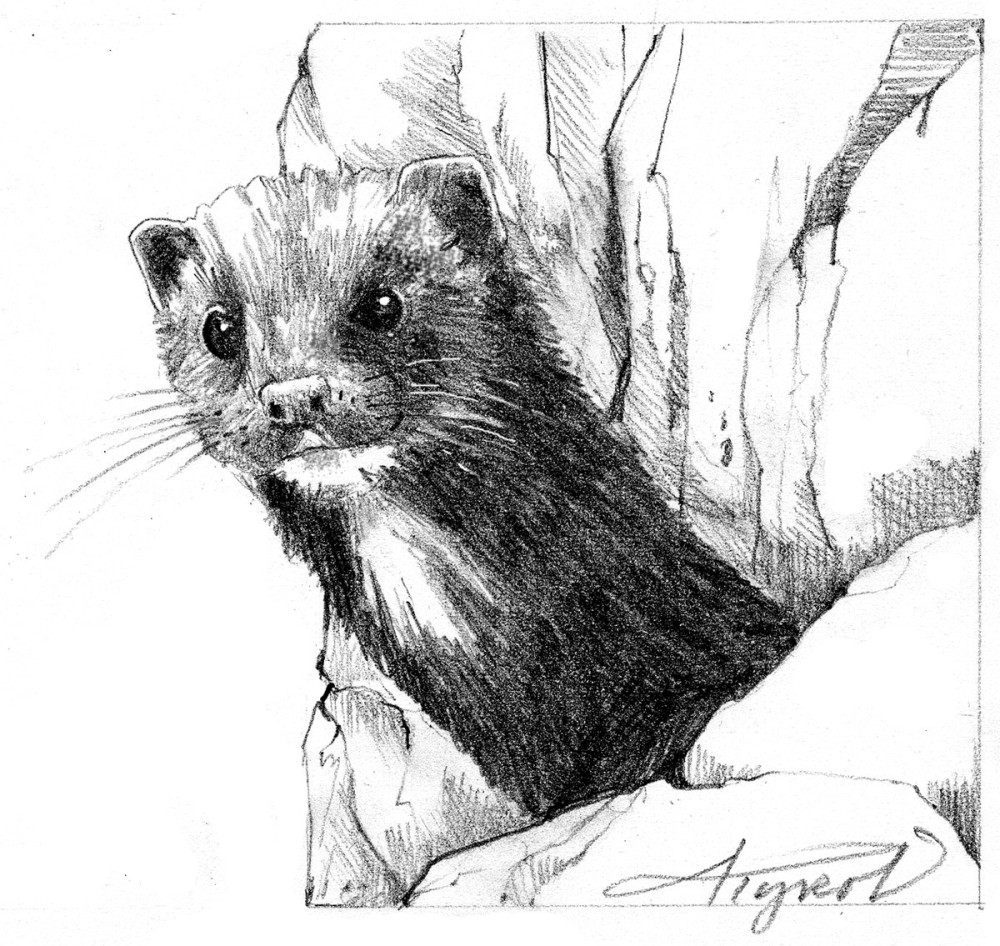
It was a cold, snowy Sunday morning in the middle of January. I planned to heed the warnings encouraging motorists to stay off the road and turned the radio on to catch the end of an interview with poet Mary Oliver, recorded in 2015. The poet had died earlier that week, at the age of 83. “Listening to the World” was the title of the conversation, ironic on a snowy morning when the earth seemed so quiet.
After breakfast, I was gazing out my kitchen window toward the river, looking beyond the woodshed attached to the far side of our garage. The snow was still falling and blowing with stiff gusts of wind. Suddenly, I saw a dash of dark fur, low to the ground. The animal was at least 18 inches long with a fluffy tail, and it bounded under the woodshed. As quickly as it appeared, it was lost from view.
By the time I went out to investigate, new and blowing snow had erased the tracks. Inside the shed, however, a thin covering of snow preserved a chain of paired prints, each pair with one print slightly off-set from the other and each set about 16 inches apart. The tracks extended from where I saw the animal dart into the shed to our wall of neatly stacked firewood. Had the animal managed to squeeze between the logs of stacked wood?
Back inside I put a log on the fire and gathered up every mammal book I could find. I started reading, and discovered the paired track pattern was indicative of a member of the Mustelid, or weasel, family. The animal was too dark and too big to be an ermine, and too small to be a fisher or otter. And so it must have been a mink. Our habitat is also consistent with that preferred by mink. A ribbon of riparian forest separates our house from the Poultney River, near the center of our small Vermont town.
Mink are widely distributed near waterways all over North America, but because they are mostly nocturnal and secretive, it’s not so common to see one. According to Lillian and Donald Stokes, the carnivores have a versatile diet, hunting for small mammals, fish, amphibians, birds, macroinvertebrates and crustaceans. With their torpedo-shaped body, mink, like their smaller weasel relatives, are nimble on land and can gain access to burrows and confined spaces to find prey.
This terrestrial nimbleness comes with a price, though: mink are not particularly well adapted to long forays in cold water. According to Peter Marchand, author of Life in the Cold, mink have a limited lung capacity, only partially webbed feet, thinner fur, and smaller deposits of subcutaneous fat than their water-loving otter cousins. Thus, it is with great energetic cost that a mink dives into cold water. The fishing strategy of mink involves travelling along the streambank and plunging quickly into the water to capture vulnerable prey.
The next day, I headed out on snowshoes to investigate. A blue sky replaced the gray sky of the day before, but it was much colder, near 0 degrees. The fresh snow lay like an untouched canvas. Near the back of our garage, I picked up the pattern of off-set tracks, this time heading out from under the garage toward the woods. Had the mink remained in the woodshed until after yesterday’s snow had ended? I followed the tracks into the woods. At times, I briefly lost the trail, but then it would re-emerge. Eventually the trail turned and arrived at the river. Abruptly at the edge of the river, the tracks stopped. I stood by the water, marveling with the realization that for the mink, this zero-degree day must have included a plunge into the river.
That night I discovered the poem “Mink” by Mary Oliver – a reflection on the gift of encountering a hungry mink (“a hot, dark-brown pillar”) in winter. The poem reinforced how harsh conditions and a fight for survival intersect with beauty and wonder on cold winter days.


Discussion *